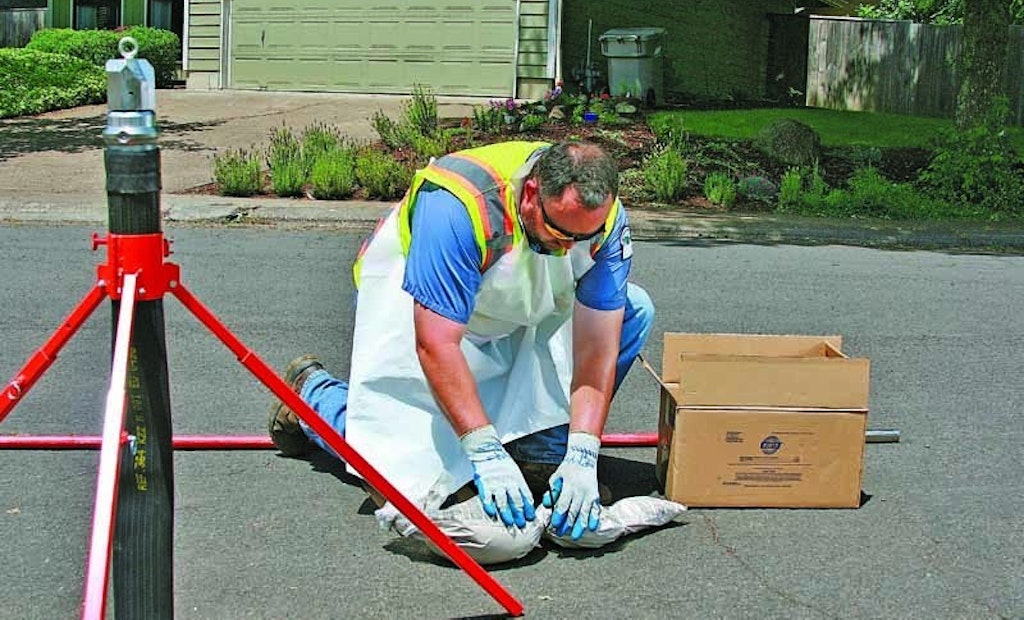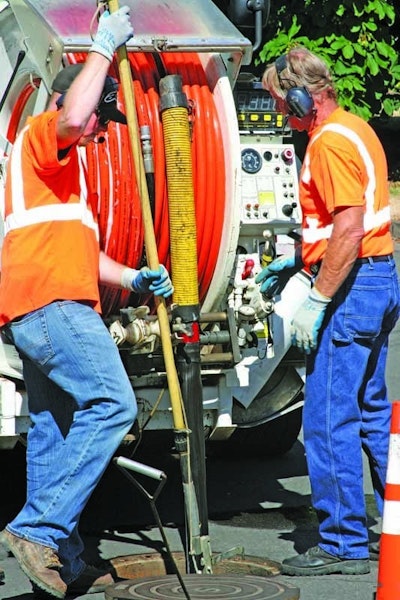
Interested in Rehab/Relining?
Get Rehab/Relining articles, news and videos right in your inbox! Sign up now.
Rehab/Relining + Get AlertsCeres, a town of about 45,000, lies at the center of California’s rich and fertile Great Central Valley. But as sewer network operators everywhere know, fertile ground can have a downside: root growth in sewer lines.
For the past decade, Ceres has been managing root control in-house. The initial impetus for getting into root control came from just one subdivision, Morrow Village. “It was built in 1957, and all the utilities and easements were put in backyards,” explains Wastewater Systems Supervisor Terry Turner. “So, it’s the only place in our network where we have to enter private property to do maintenance. Plus, the city has no control over plantings in backyards, so there are all sorts of trees and shrubs — that means lots of roots.”
The Morrow Village sewer main network includes 6.25 miles of 6- and 8-inch vitrified clay pipe running about 6 feet underneath backyards, and roots find their way into the pipe through mortar joints and small cracks. Once roots are in, they grow and expand rapidly, causing backups and damaging pipe.
“Prior to 2006, we averaged 12 callouts per year for backups caused by roots, just in Morrow Village,” Turner says. “Most of those were emergency callouts, costing us overtime and sometimes making it even harder to get into backyards without doing damage. It was an expensive problem, it affected service and it was only getting worse as the clay pipes continued to crack.”
Given the location, replacing the VCP with HDPE or similar pipe was not an attractive option — trenching and replacing on private property is the kind of “solution” that network managers like to defer as long as possible.
A good program
Turner says Ceres was attracted to RootX because it’s relatively mild and has no significant downstream consequences. It’s also simple to use and the initial investment was minimal.
“We really like to do things in-house, to keep costs down,” Turner says. “It just makes sense to use our own manpower and to get more out of our investment in equipment. We’ve had companies submit bids, but they just can’t compete on price. So, we’ve elected to keep control.”
After beginning the program in Morrow Village, Ceres established a biannual schedule that keeps roots under control. “We service the subdivision every two years, and we’re on site approximately three weeks,” Turner says. “We work in 300-foot runs, from manhole to manhole (manholes are also in backyards), and we’re able to schedule the work with owners, so they can clear a path for us.”
During this three-week period, the city deploys a four-man crew with a jet/vac truck, an easement machine and a regular service truck. The actual workflow is straightforward; crews set up the combination truck as near to the manhole as possible and move the easement machine into the backyard.
After hoses are hooked up, actual pipe treatment begins with a flush of the pipe. “We always clean the pipe first,” Turner explains. “We use a nozzle we call a sand head, which is a little larger than the RootX applicator. Cleaning is important, because the treatment works better on vigorous, healthy roots — they take up the herbicide more effectively.”
Due to the access issues, crews will proceed with herbicide foaming immediately after cleaning. Where access isn’t an issue, it is sometimes better to wait a few weeks after cleaning so that roots have time to recover and grow a bit before treating.
Turner says that foaming has turned out to be a key factor in the success of Ceres’ root control program. “The foam coats the whole pipe, sticks to roots and leaves a residue of herbicide on the upper pipe interior surfaces, where roots typically come in,” he explains.
“That will stay active, killing off new roots that find cracks. It really works well, and unless we have some sort of storm event that floods pipes, the residual will stay in place for up to two years.”
One advantage of applying root control in a limited area, like a subdivision, is that it is relatively easy to measure results and return on investment — in effect, the root control program served as a large, well-studied pilot project. Obviously the results were encouraging, and Ceres is now extending the root control program to the entire sewer network.
Good numbers
Ceres, like most of California, has been experiencing drought conditions for several years. Counterintuitively, drought actually exacerbates the root challenge, all over the city. “The thing with roots, especially in drought, is that the trees are not getting what they need in terms of moisture, so they dive in deeper and will seek out any little pinhole they can find,” Turner says. “Drought has also led to a few more vacant houses, where plants aren’t being watered or cared for — that also leads to more aggressive roots.”
Although Morrow Village access issues were the main impetus for investing in a root control program, Ceres quickly extended the program to the entire network. Outside the subdivision, root treatment is more reactive. The city has its own CCTV crew and inspects about 5 percent of the network annually. When root growth is identified by video or other means, RootX is applied, and the pipe area is scheduled for a follow-up inspection.
Since the city developed its root control program, the change has been dramatic. Turner now receives just two callouts per year in Morrow Village, and those are mostly for problems in the owner-controlled lateral lines.
“It’s nice,” Turner says. “I can prove we’re saving money, we’re providing better service and the callouts now are rarely emergencies — that means we can coordinate with owners, come out on a normal workday, and access is much easier for everyone.”






